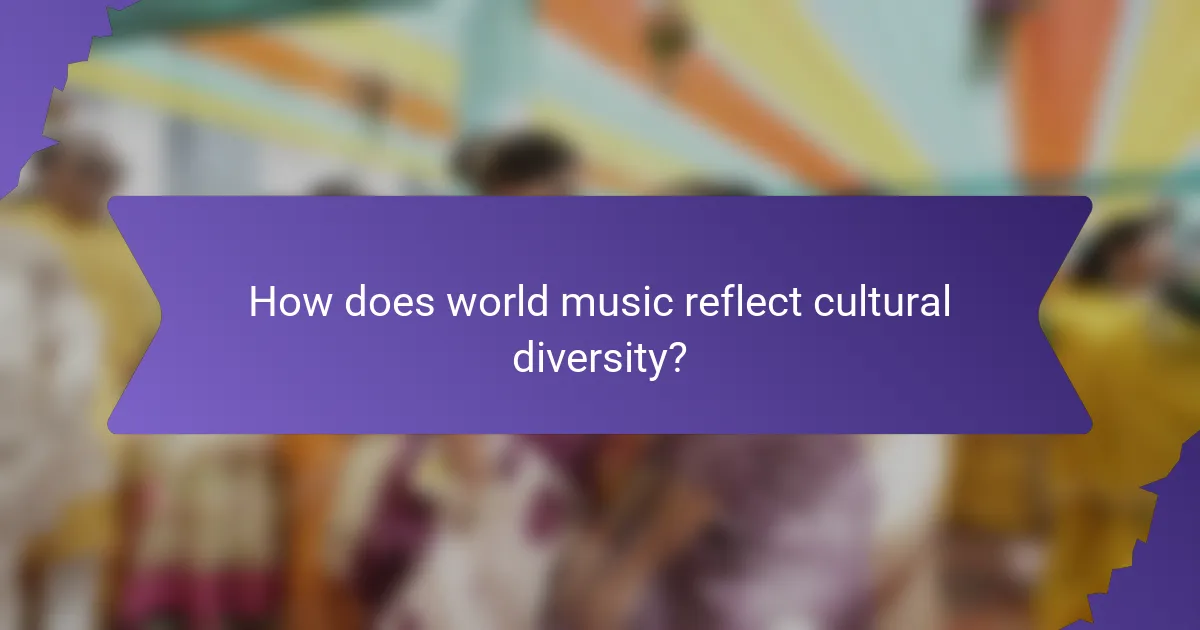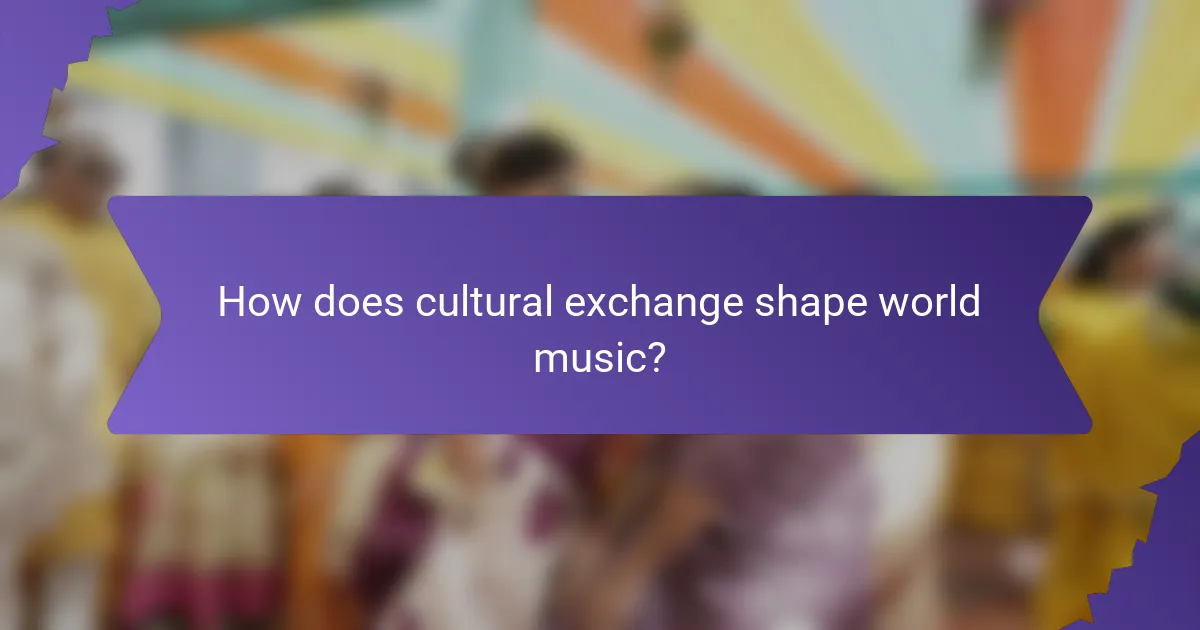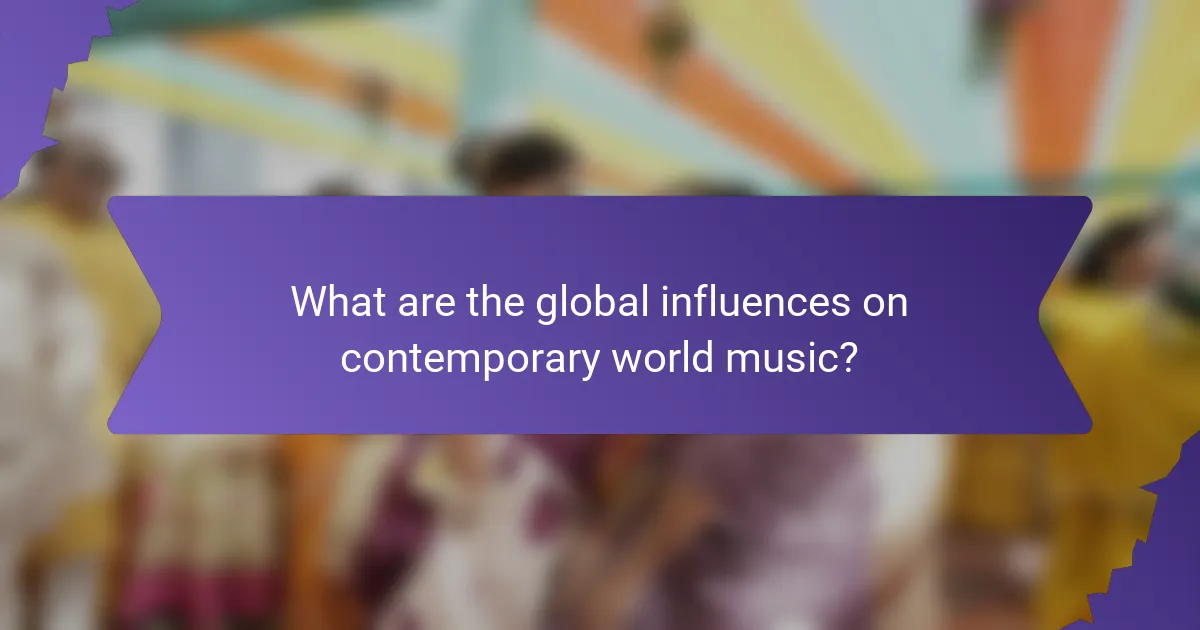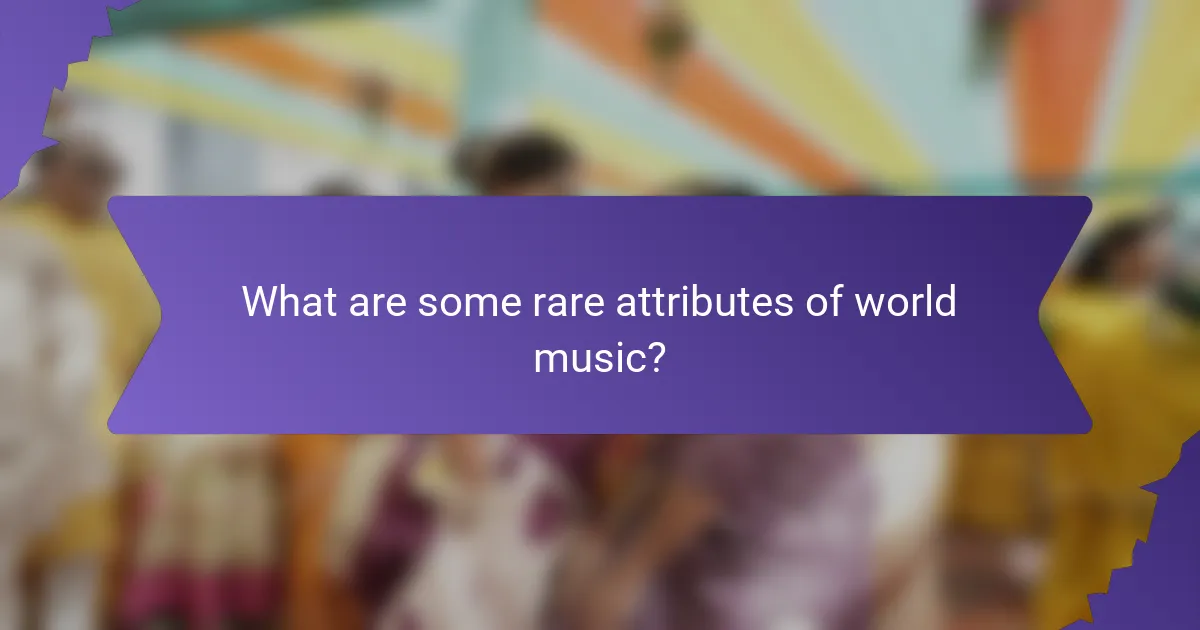World music offers a rich tapestry of diverse musical styles that reflect cultural heritage and identity. It fosters cultural exchange through the blending of traditions, creating innovative genres and sounds. Global platforms enhance accessibility and collaboration among artists, promoting understanding across communities. Unique instruments and regional rhythms further distinguish these musical practices, enriching the global music landscape.

How does world music reflect cultural diversity?
World music reflects cultural diversity by showcasing distinct musical styles and traditions from various cultures. Each genre embodies unique attributes, such as instrumentation and rhythms, that tell stories of heritage and identity. Music serves as a medium for cultural exchange, fostering understanding and appreciation among different communities. For instance, the fusion of African rhythms with Western pop illustrates how global influence shapes musical landscapes. Additionally, world music festivals promote cultural awareness and celebrate the richness of global artistry.
What are the key characteristics of world music genres?
World music genres are characterized by their diverse cultural influences, unique soundscapes, and the blending of traditional and contemporary elements. These genres often reflect the social and historical contexts of their origins.
Key characteristics include the incorporation of local instruments, distinct rhythms, and vocal styles. For example, African music often features polyrhythmic patterns, while Latin music showcases vibrant melodies and danceable beats.
Another attribute is the emphasis on storytelling, where lyrics convey cultural narratives and traditions. Additionally, world music genres frequently engage in cross-cultural collaborations, enhancing global influence and promoting cultural exchange.
The unique attribute of world music is its ability to evolve, absorbing influences from various cultures while maintaining its distinct identity. This dynamic nature fosters innovation and keeps the genres relevant in a globalized world.
Which instruments are commonly used in different world music traditions?
Various instruments are integral to world music traditions, reflecting cultural diversity. Common instruments include the sitar from India, the djembe from West Africa, the erhu from China, the accordion in European folk music, and the didgeridoo from Australia. Each instrument embodies unique attributes that contribute to its cultural significance and sound. For example, the sitar has a complex structure with multiple strings, while the djembe is known for its versatile rhythm and craftsmanship. These instruments facilitate cultural exchange and highlight the global influence of music.

How does cultural exchange shape world music?
Cultural exchange profoundly shapes world music by blending diverse musical traditions. This interaction fosters innovation, creating new genres and styles that reflect a globalized society.
One key aspect is the fusion of instruments and rhythms, leading to unique sounds. For example, the incorporation of African rhythms into jazz or the blend of traditional folk music with contemporary pop illustrates this dynamic.
Cultural exchange also enhances collaboration among artists from different backgrounds. These partnerships often result in cross-genre experimentation, enriching the musical landscape.
Moreover, global platforms such as social media facilitate the rapid spread of diverse musical influences. This connectivity allows artists to reach broader audiences, further promoting cultural diversity in music.
What role do festivals play in promoting world music?
Festivals play a crucial role in promoting world music by fostering cultural exchange and celebrating diversity. They provide platforms for artists from various backgrounds to showcase their music, creating opportunities for collaboration. Festivals attract diverse audiences, enhancing appreciation for global music traditions. For example, events like the World Music Festival in Chicago highlight the rich tapestry of sounds and styles from around the world, encouraging cross-cultural dialogue. This exchange not only enriches local communities but also influences global music trends, making festivals vital in the evolution of world music.
How do collaborations between artists influence musical styles?
Collaborations between artists significantly enrich musical styles by blending diverse influences. This fusion leads to innovative sounds that reflect cultural exchange and global perspectives.
For instance, collaborations between artists from different backgrounds often result in unique genres. The merging of traditional instruments with modern techniques creates fresh auditory experiences. This evolution is evident in world music, which incorporates elements from various cultures, enhancing its appeal.
Moreover, collaborations can introduce audiences to unfamiliar musical traditions. By showcasing diverse styles, artists foster appreciation for cultural heritage. This exchange not only broadens listeners’ horizons but also encourages the preservation of musical diversity.
In summary, artist collaborations transform musical styles by integrating diverse influences, promoting cultural appreciation, and driving innovation in sound.

What are the global influences on contemporary world music?
Global influences on contemporary world music include cultural exchange, technology, and migration. These factors enhance diversity and accessibility, shaping music styles and practices worldwide. Cultural exchange introduces new rhythms and instruments, while technology facilitates global collaboration. Migration allows artists to blend traditions, creating innovative genres. This interconnectedness enriches the global music landscape, reflecting shared human experiences.
How has technology changed the way world music is produced and consumed?
Technology has transformed world music production and consumption by enhancing accessibility and collaboration. Digital platforms allow artists from diverse backgrounds to share their work globally. Streaming services have democratized music access, enabling listeners to explore various genres and cultures easily. Additionally, advancements in production software facilitate innovative sound creation, blending traditional styles with modern techniques. The result is a rich tapestry of global influences that redefine musical boundaries and foster cultural exchange.
Which social media platforms are most effective for sharing world music?
Facebook, Instagram, and YouTube are the most effective platforms for sharing world music. These platforms facilitate cultural exchange and global influence by allowing artists to reach diverse audiences.
Facebook supports community building through groups and events, while Instagram’s visual storytelling enhances engagement. YouTube allows for extensive reach with music videos and tutorials, catering to a global audience.
TikTok is emerging as a strong contender, enabling viral trends and short music clips that promote world music. Each platform offers unique features that enhance the sharing experience, making them vital for artists and fans alike.

What unique attributes distinguish specific world music traditions?
Unique attributes that distinguish specific world music traditions include distinct instrumentation, cultural narratives, and regional rhythms. For example, Indian classical music features the sitar, while African drumming emphasizes polyrhythms. These elements contribute to the identity and authenticity of each tradition, reflecting the cultural heritage and social context of their origins. The fusion of these diverse musical styles in contemporary genres showcases the global influence and cultural exchange inherent in world music.
How does regional folklore influence musical expression?
Regional folklore significantly shapes musical expression by embedding cultural narratives and traditional practices into music. These influences manifest in various ways, including instrumentation, lyrical themes, and performance styles. For instance, folk tales often inspire song lyrics, preserving history and community values. Unique regional instruments, such as the sitar in India or the djembe in West Africa, reflect distinct cultural identities. Additionally, musical forms evolve through cultural exchange, as artists blend traditional elements with contemporary styles, creating new genres. This dynamic interplay fosters a rich tapestry of global music, illustrating the profound impact of regional folklore on artistic expression.
Which world music styles are experiencing a revival in popularity?
Several world music styles are experiencing a revival in popularity, including Afrobeat, Reggae, and Flamenco. These genres are gaining traction due to cultural exchange and global influence. Afrobeat blends traditional African rhythms with jazz and funk, attracting new audiences. Reggae’s themes of social justice resonate strongly today, while Flamenco’s passionate expression captivates listeners worldwide. These revivals highlight the dynamic nature of world music and its ability to adapt and thrive in contemporary contexts.

What are some rare attributes of world music?
Rare attributes of world music include unique instruments, specific cultural rituals tied to performances, and distinct regional scales. These elements reflect the diverse cultural heritage and traditions from various parts of the globe. For instance, the use of the didgeridoo in Australian Aboriginal music showcases a rare instrument that embodies spiritual significance. Additionally, certain world music genres incorporate traditional storytelling methods that are not found in mainstream music. These unique traits contribute to the rich tapestry of global musical expression.
How do traditional practices impact modern interpretations of world music?
Traditional practices significantly influence modern interpretations of world music by preserving cultural identities and fostering global dialogue. These practices provide a foundation for contemporary artists, who often blend traditional elements with modern styles. For instance, the use of indigenous instruments and rhythms can be seen in genres like worldbeat and fusion. Additionally, cultural exchange through collaborations enhances the richness of global music, allowing for diverse expressions. This interplay between tradition and innovation showcases how heritage shapes contemporary sounds, making world music a dynamic field.
What are the challenges faced by niche world music genres?
Niche world music genres face challenges such as limited exposure, funding difficulties, and audience reach. These genres often struggle to compete with mainstream music, leading to underrepresentation. Cultural appropriation can also pose issues, as it may dilute authenticity. Additionally, the digital landscape can create barriers for niche genres to gain traction, despite potential global interest.

How can listeners engage with world music more deeply?
Listeners can engage with world music more deeply by exploring its diverse genres, attending live performances, and participating in cultural events. Engaging with world music allows individuals to appreciate cultural exchange and the global influence of different musical traditions.
One effective way is through active listening. This involves focusing on the rhythms, instruments, and lyrics while understanding their cultural significance. For example, listeners can research the background of specific genres, such as Afrobeat or Flamenco, to gain insight into their origins and meanings.
Another method is to attend workshops or classes that teach traditional music styles. This hands-on experience fosters a deeper connection to the music and its cultural roots. Participating in community events or festivals can also enhance understanding and appreciation by immersing listeners in the cultural context of the music.
Finally, utilizing digital platforms such as streaming services or social media can broaden exposure to world music. Curated playlists and artist interviews provide valuable context and recommendations, allowing listeners to discover new artists and genres while fostering a global musical community.
What are the best practices for discovering new world music artists?
To discover new world music artists, explore diverse platforms and communities. Utilize streaming services, attend cultural festivals, and engage with social media groups focused on world music.
Streaming platforms often feature curated playlists highlighting emerging artists. Cultural festivals provide live performances and opportunities to connect with artists directly. Social media groups foster discussions and recommendations, broadening your exposure to global sounds.
Engaging with local music scenes can also uncover hidden talents. Collaborating with music enthusiasts or participating in workshops expands your network and knowledge.
Each of these practices enhances your understanding of the diversity and cultural exchange inherent in world music.
How can music education incorporate world music elements effectively?
World music education can effectively incorporate world music elements by integrating diverse cultural perspectives, fostering creativity, and enhancing global awareness. Educators should include traditional instruments, music styles, and practices from various cultures to enrich students’ learning experiences.
Collaborative projects that involve students in exploring and performing world music can deepen their appreciation for cultural diversity. For instance, incorporating folk songs from different regions encourages students to engage with the cultural context behind the music.
Additionally, using technology to access global music resources allows students to explore a wide range of musical traditions. This approach not only broadens their musical repertoire but also promotes cultural exchange and understanding.
Finally, inviting guest musicians from different backgrounds can provide firsthand insights into the cultural significance of their music, making the learning experience more immersive and impactful.
What common mistakes should listeners avoid when exploring world music?
Listeners exploring world music should avoid common mistakes that hinder appreciation and understanding. These include generalizing cultures, neglecting context, and focusing solely on popular genres.
Generalizing cultures can lead to misconceptions about diverse musical traditions. Each culture has unique attributes that contribute to its sound. Neglecting context, such as historical and social influences, can diminish the music’s significance. Focusing only on popular genres may limit exposure to the rich variety within world music.
Engaging with local artists and attending live performances can enhance understanding. This approach fosters cultural exchange and appreciation. Listening actively and seeking out lesser-known works can deepen the experience.